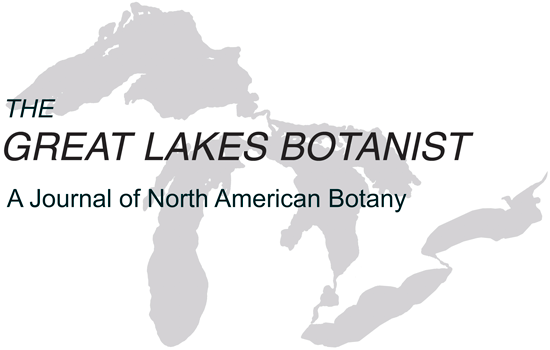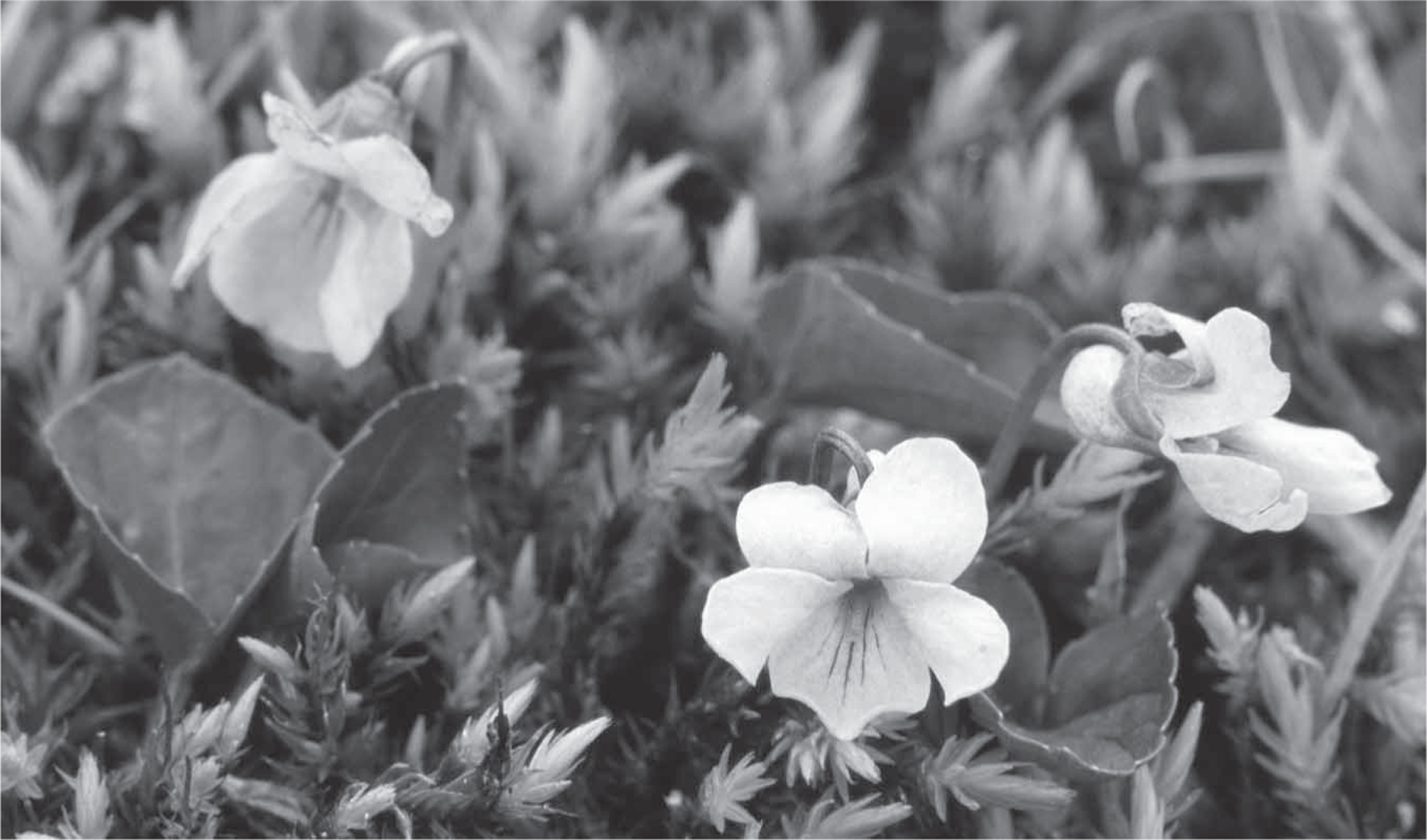Significance of the report.
The boreal and arctic Viola epipsila Ledeb. subsp. repens W.Becker (Dwarf Marsh Violet, Figures 1 and 2) is reported for the second time in the eastern United States.
Previous knowledge.
Subsection Stolonosae (Kupffer) Kupffer of Sect. Plagiostigma Godr., to which Viola epipsila Ledeb. subsp. repens W.Becker belongs, is the sixth largest infrageneric group in Viola with 41 species (Marcussen et al. 2022). Members of Subsection Stolonosae, often colloquially known as the “acaulescent white” violets, are distributed over the northern hemisphere and differ from other acaulescent violets in their slender rhizome, commonly stoloniferous habit, undivided leaf blades, membranous glandular-lacerate commonly non-adnate stipules, white or pale violet flowers with short thick saccate spur, style with margined and flattened apex, and base chromosome number of x = 24 (ancestrally allotetraploid, Marcussen et al. 2012). A recognizable assemblage of taxa in the Stolonosae is informally named the “Palustres” after the earliest published member Viola palustris L. “Palustres” violets share unusual features of creeping surficial rhizome (vs. horizontal to erect subterranean rhizomes) and lateral stoloniform rhizomes, leaves inserted separately behind the apical meristem (vs. leaves clustered into rosettes), pale violet or violettinged flowers (vs. white flowers), and ovate semi-sheathing stipules (vs. lanceolate non-sheathing stipules). Allopolyploidization events within and between “Palustres” and non-“Palustres” Stolonosae have produced various allo-octoploid derivatives; those involving at least one “Palustres” parent species have been retained in the “Palustres”.
The “Palustres” group is circumboreal and includes three tetraploid taxa (one in eastern Eurasia and North America, two in Eurasia) and three octoploid taxa (two in North America, and one circumboreal). The tetraploids consist of Viola epipsila subsp. epipsila in western Eurasia; Viola suecica Fr. in Europe; and Viola epipsila subsp. repens in eastern Eurasia and Alaska to western Ontario, southward into the Rocky Mountains and the northern Great Lakes region. Wilhelm Becker (1917) included Viola suecica in Viola epipsila and recognized two subspecies under Viola epipsila, subsp. epipsila and subsp. repens. Marcussen and others (unpublished) have found that Viola epipsila subsp. epipsila and Viola suecica in Eurasia are distinct and should be maintained as separate species, while Viola epipsila subsp. repens is conspecific with Viola suecica, not with Viola epipsila sensu stricto as Becker interpreted. Viola suecica sensu stricto and Viola epipsila subsp. repens are distinguishable and are best treated as subspecies; the name subsp. repens will require a future transfer to Viola suecica. Our North American tetraploid “Palustres” violet should be recognized in future at the species level as Viola suecica Fr., but it is retained under the familiar name of Viola epipsila in this announcement to avoid confusion.
Octoploid (2n = 48) members of the “Palustres” group are Viola palustris subsp. palustris in Europe and North America, southward into the Rocky Mountains and New England; Viola pluviae Marcussen, H.E.Ballard & Blaxland in the far western Rocky Mountains of North America; and Viola palustris subsp. brevipes M.S.Baker in the Rocky Mountains of southwestern Canada and western United States. Morphological, cytological and phylogenetic evidence urges elevation of subsp. brevipes to species rank in the future.
The first record of V. epipsila subsp. repens in the United States east of the Rocky Mountains was made by Ballard (1985), based on a BLH herbarium sheet of plants taken from Manitou Island in Keweenaw County, Michigan. Viola palustris subsp. palustris has been well documented from the high mountains of New Hampshire and Maine (Haines et al. 2011) but has not been found in the Great Lakes or Great Plains regions south of the international boundary. Conversely, V. epipsila has not been found in the eastern U.S. range of V. palustris. Both occur in central Canada, where they may co-occur.
Discussion.
Two recently reidentified specimens at the University of Minnesota Herbarium (MIN) of Viola epipsila Ledeb. subsp. repens W.Becker, collected from Pennington Bog Scientific and Natural Area in Beltrami County in northern Minnesota, represent the second report of this violet south of the Canadian border in the eastern United States. These two collections were originally identified as Viola pallens (Banks ex Ging.) Brainerd. The Minnesota Department of Natural Resources’ webpage (Minnesota DNR 2021) for the SNA describes the site as a “little-disturbed tract of … northern cedar swamp.” Although the collections were made in 1979, the site presumably still harbors the species. What appears to be a somewhat dense Thuja swamp along Sucker Creek at the SNA, based on examination of the site using GoogleEarth (2022), is similar in nature to numerous other sites in northern Minnesota. The species should be sought elsewhere in the region, especially in adjacent counties and in the northern two tiers of counties of Minnesota bordering Canada. Until the species has been documented in other areas of the state, Endangered status in Minnesota seems warranted.
Distinguishing Viola epipsila subsp. repens from V. palustris subsp. palustris in central and eastern North America is not especially difficult; the task is somewhat greater in western North America, where three or four “Palustres” taxa may co-occur. Hybridization among the “Palustres” violets is not rare (Sorsa 1968 and citations therein; Blaxland 2021) and is exacerbated by hybridization with other Stolonosae, particularly Viola minuscula Greene1.
Diagnostic characters.
Tetraploid Viola epipsila subsp. repens can be distinguished from the three octoploid North American taxa (V. palustris subsp. brevipes, V. palustris subsp. palustris, and V. pluviae) in having 1–2 leaves (vs. (2)3–5 leaves) per rhizome or stolon, peduncular bracts usually positioned above the middle and often near the apex (vs. below the middle to slightly above it), abaxial surface of leaf blades commonly finely pubescent along veins (vs. leaf blades strictly glabrous), flower pale violet (vs. white, white with violet tinge, or pale violet), and lateral petals sparsely bearded (vs. glabrous) within.
Specimen citations.
Minnesota, Beltrami County: Pennington Orchid Bog SNA [correct name: Pennington Bog Scientific and Natural Area], 1 mile north of Pennington, NW1/4 sec. 3, T 146N, R 30W, Stream edge [= Sucker Creek] in Cedar Bog, August 19, 1979, Keller 9 (MIN 715630); Keller 33 (MIN 715584).
ACKNOWLEDGMENTS
The author thanks the curatorial staff at the University of Minnesota Herbarium for providing access to the collection, Chris Blaxland for permission to use the late Kim Blaxland’s excellent images, and two anonymous reviewers and Michael Huft for improvements to the manuscript.
Notes
- This is the species in eastern North America that has most recently been called Viola mackloskeyi F.E. Lloyd or sometimes V. pallens (Banks ex Ging.) Brainerd. However, recent unpublished research indicates that Viola mackloskeyi is restricted to western North America and that the best name available for the eastern populations is V. minuscula (see Marcussen et al. 2012; Ballard 2020; Ballard et al. 2022). ⮭
LITERATURE CITED
Ballard, H. E. Jr. (1985). Viola epipsila new to Michigan and the eastern United States. The Michigan Botanist 24: 131–134.
Ballard, H. E. Jr. (2020). Violets (Violaceae) of the Great Plains and eastern North America. Available at https://people.ohio.edu/ballardh/vgpena/.https://people.ohio.edu/ballardh/vgpena/ (Accessed November 28, 2021).
Ballard, H. E., Jr., B. A. Sorrie, and A. S. Weakley. (2022). Viola. Pp. 934–950 in Weakley, A. S., and Southeastern Flora Team 2022. Flora of the southeastern United States. University of North Carolina Herbarium, North Carolina Botanical Garden.
Blaxland, K. (2021). Botany by Kim Blaxland. Available at http://botanikim.com/.http://botanikim.com/ (Accessed November 28, 2021).
Blaxland, K., H. E. Ballard, Jr., and T. Marcussen. (2018). Viola pluviae (Violaceae), a new “Palustres” violet in the Pacific Northwest of North America. Nordic Journal of Botany 36 (9): n/a [doi: 10.1111/njb.0193110.1111/njb.01931].
Haines, A., E. Farnsworth, and G. Morrison. (2011). New England Wild Flower Society’s Flora Novae Angliae: A manual for the identification of native and naturalized higher vascular plants of New England. Yale University Press, New Haven, Connecticut.
Marcussen, T., H. E. Ballard, J. Danihelka, A. R. Flores, M. V. Nicola, and J. M. Watson. (2022). A revised phylogenetic classification for Viola (Violaceae). Plants, in press.
Marcussen, T., and T. Karlsson. (2010). Violaceae. Pp. 12–52 in Flora Nordica, Volume 6. B. Jonsell and T. Karlsson, editors. Stockholm, Sweden.
Marcussen, T., K. S. Jakobsen, J. Danihelka, H. E. Ballard, K. Blaxland, A. K. Brysting, and B. Oxelman. (2012). Inferring species networks from gene trees in high-polyploid North American and Hawaiian violets (Viola, Violaceae). Systematic Biology 60: 1–20.
Minnesota Department of Natural Resources. (2021). Pennington Bog SNA. Available at https://www.dnr.state.mn.us/snas/detail.html?id=sna00957.https://www.dnr.state.mn.us/snas/detail.html?id=sna00957 (Accessed November 28, 2021).
Sorsa, M. (1968). Cytological and evolutionary studies on palustres violets. Madroño 19: 165–179.


